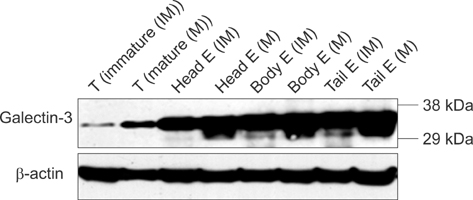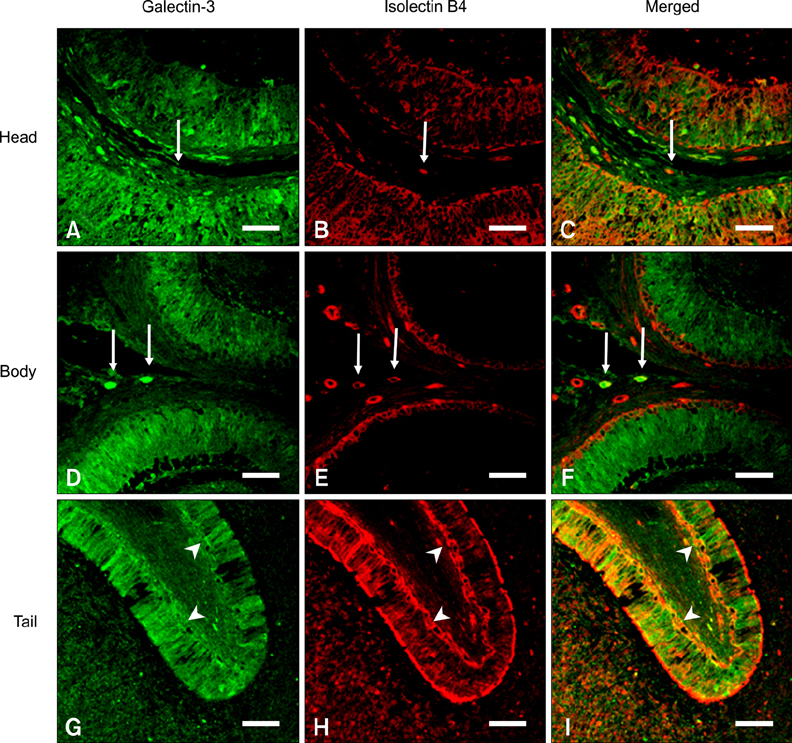J Vet Sci.
2008 Dec;9(4):339-344. 10.4142/jvs.2008.9.4.339.
Immunohistochemical study of galectin-3 in mature and immature bull testis and epididymis
- Affiliations
-
- 1College of Veterinary Medicine, Cheju National University, Jeju 690-756, Korea. shint@cheju.ac.kr
- 2Applied Radiological Science Research Institute, Cheju National University, Jeju 690-756, Korea.
- 3Veterinary Laboratory, Jeju Special Self-Governing Province, Jeju 690-962, Korea.
- 4Department of Veterinary Anatomy, College of Veterinary Medicine, Chonnam National University, Gwangju 500-757, Korea.
- 5Department of Veterinary Obstetrics, College of Veterinary Medicine, Kyungpook National University, Daegu 702-701, Korea.
- KMID: 1104907
- DOI: http://doi.org/10.4142/jvs.2008.9.4.339
Abstract
- Galectin-3, a member of the beta-galactoside-binding protein family, has been implicated in mammalian sperm maturation. We examined galectin-3 expression in the testis and epididymis of sexually mature and immature bulls. Western blot analysis showed varying levels of galectin-3 in the bull testis and epididymis, and galectin-3 immunoreactivity was higher in the mature testis and epididymis than in immature organs. Galectin-3 was primarily localized in interstitial cells of the immature bull testis and in the peritubular myoid and interstitial cells of the mature testis. In the immature epididymis head, galectin-3 was primarily in the principal and basal cells of the epithelium. In the mature epididymis head, moderate levels of galectin-3 were detected in the sperm, while low levels were found in the stereocilia, epithelium and connective tissue. In the immature epididymis body, moderate protein levels were detected in the principal cells, while lower levels were found in the basal cells. The mature epididymis body showed moderate levels of galectin-3 immunostaining in the stereocilia and epithelium, but low levels in the connective tissue. In the immature epididymis tail, only low levels of galectin-3 staining were found in the epithelium, whereas the mature epididymis tail showed high levels of galectin-3 in the principal cells, moderate levels in the basal cells and low levels in connective tissue. These findings suggest that galectin-3 expression plays a role in the maturation and activation of sperm in bulls.
Keyword
MeSH Terms
Figure
Cited by 1 articles
-
Immunohistochemical localization of galectin-3 in the granulomatous lesions of paratuberculosis-infected bovine intestine
Juyeon Lee, Changjong Moon, Jihoon Kim, Chanwoo Jung, Keun-Hwa Lee, Hong-Gu Joo, Meejung Ahn, Taekyun Shin
J Vet Sci. 2009;10(3):177-180. doi: 10.4142/jvs.2009.10.3.177.
Reference
-
1. Almkvist J, Karlsson A. Galectins as inflammatory mediators. Glycoconj J. 2004. 19:575–581.
Article2. Barondes SH, Cooper DN, Gitt MA, Leffler H. Galectins. Structure and function of a large family of animal lectins. J Biol Chem. 1994. 269:20807–20810.
Article3. Dacheux JL, Castella S, Gatti JL, Dacheux F. Epididymal cell secretory activities and the role of proteins in boar sperm maturation. Theriogenology. 2005. 63:319–341.
Article4. Deschildre C, Ji JW, Chater S, Dacheux F, Selva J, Albert M, Bailly M, Hatey F, Benahmed M. Expression of galectin-3 and its regulation in the testes. Int J Androl. 2007. 30:28–40.
Article5. Devouassoux-Shisheboran M, Deschildre C, Mauduit C, Berger G, Mejean-Lebreton F, Bouvier R, Droz JP, Fénichel P, Benahmed M. Expression of galectin-3 in gonads and gonadal sex cord stromal and germ cell tumors. Oncol Rep. 2006. 16:335–340.
Article6. Dumic J, Dabelic S, Flögel M. Galectin-3: an open-ended story. Biochim Biophys Acta. 2006. 1760:616–635.
Article7. Flint FF, Schulte BA, Spicer SS. Glycoconjugate with terminal alpha galactose. A property common to basal cells and a subpopulation of columnar cells of numerous epithelia in mouse and rat. Histochemistry. 1986. 84:387–395.8. Ha TY, Ahn MJ, Lee YD, Yang JH, Kim HS, Shin TK. Histochemical detection of glycoconjugates in the male reproductive system of the horse. J Vet Sci. 2003. 4:21–28.
Article9. Judd WJ, Murphy LA, Goldstein IJ, Campbell L, Nichols ME. An anti-B reagent prepared from the alpha-D-galactopyranosyl-binding isolectins from Bandeiraea simplicifolia seeds. Transfusion. 1978. 18:274–280.
Article10. Kaltner H, Seyrek K, Heck A, Sinowatz F, Gabius H. Galectin-1 and galectin-3 in fetal development of bovine respiratory and digestive tracts. Comparison of cell type-specific expression profiles and subcellular localization. Cell Tissue Res. 2002. 307:35–46.
Article11. Kim H, Kang TY, Joo HG, Shin T. Immunohistochemical localization of galectin-3 in boar testis and epididymis. Acta Histochem. 2006. 108:481–485.
Article12. Leffler H, Masiarz FR, Barondes SH. Soluble lactose-binding vertebrate lectins: a growing family. Biochemistry. 1989. 28:9222–9229.
Article13. Liu FT, Patterson RJ, Wang JL. Intracellular functions of galectins. Biochim Biophys Acta. 2002. 1572:263–273.
Article14. Nangia-Makker P, Sarvis R, Visscher DW, Bailey-Penrod J, Raz A, Sarkar FH. Galectin-3 and L1 retrotransposons in human breast carcinomas. Breast Cancer Res Treat. 1998. 49:171–183.
Article15. Ong CN, Shen HM, Chia SE. Biomarkers for male reproductive health hazards: are they available? Toxicol Lett. 2002. 134:17–30.
Article16. Rabinovich GA, Baum LG, Tinari N, Paganelli R, Natoli C, Liu FT, Iacobelli S. Galectins and their ligands: amplifiers, silencers or tuners of the inflammatory response? Trends Immunol. 2002. 23:313–320.
Article17. Stowell SR, Qian Y, Karmakar S, Koyama NS, Dias-Baruffi M, Leffler H, McEver RP, Cummings RD. Differential roles of galectin-1 and galectin-3 in regulating leukocyte viability and cytokine secretion. J Immunol. 2008. 180:3091–3102.
Article18. Takenaka Y, Fukumori T, Raz A. Galectin-3 and metastasis. Glycoconj J. 2004. 19:543–549.
Article19. Uehara F, Ohba N, Ozawa M. Isolation and characterization of galectins in the mammalian retina. Invest Ophthalmol Vis Sci. 2001. 42:2164–2172.20. Van den Brûle FA, Fernandez PL, Buicu C, Liu FT, Jackers P, Lambotte R, Castronovo V. Differential expression of galectin-1 and galectin-3 during first trimester human embryogenesis. Dev Dyn. 1997. 209:399–405.
Article
- Full Text Links
- Actions
-
Cited
- CITED
-
- Close
- Share
- Similar articles
-
- Adenomatoid tumor of the epididymis associated with intraperitoneal cryptorchid testis
- A case of congenital retroperitoneal immature teratoma
- The Significance of Immunohistochemical Staining in Thyroid Nodule: TPO and Galectin-3
- SPERMATOGENESIS
- Localization of S-100 proteins in the testis and epididymis of poultry and rabbits




